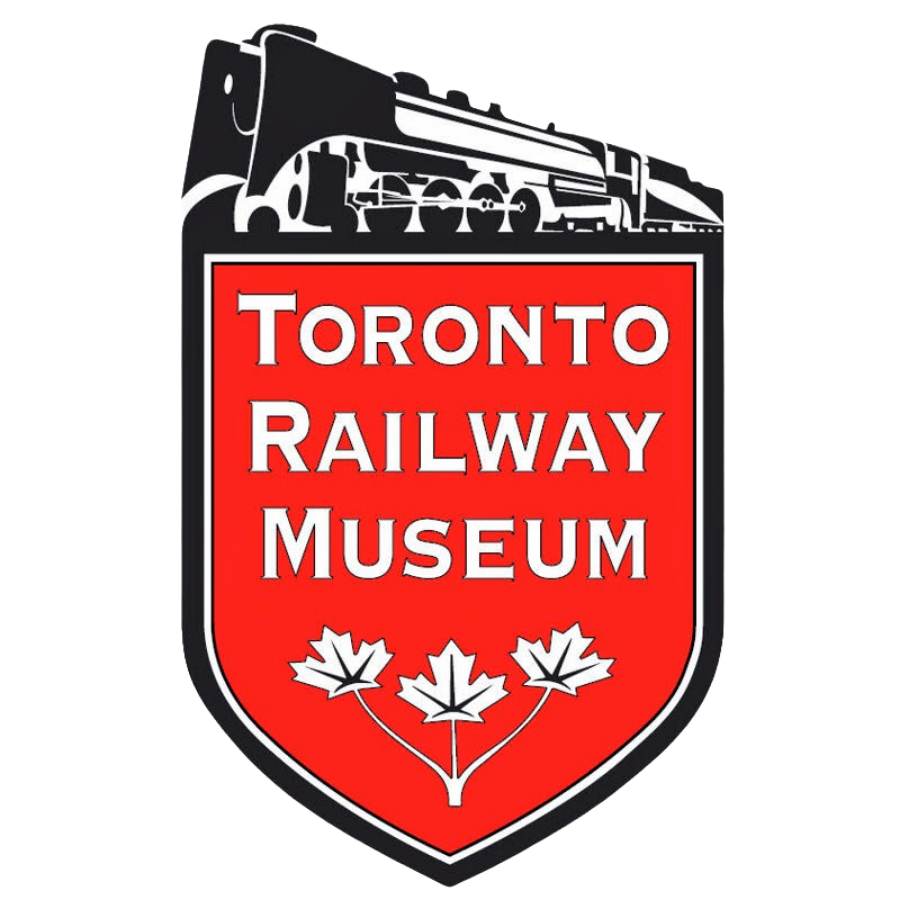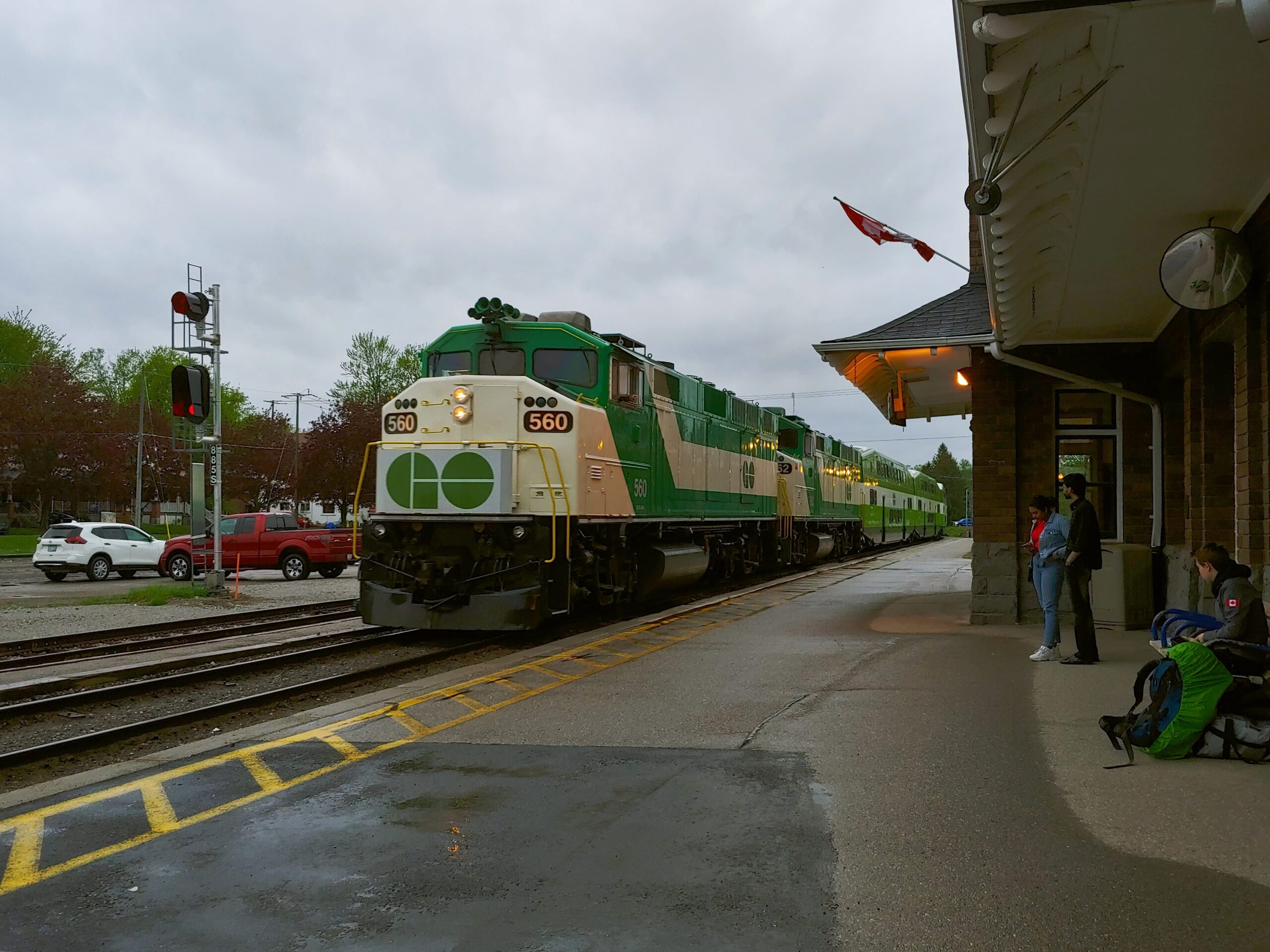Crossing The GO Network: A First Person Perspective of Riding The GO Train from Stratford to Whitby
Overview:
In October 2021, Metrolinx announced it would begin operating GO trains between London and Toronto as part of a pilot project. Operating along the secondary Canadian National mainline via Kitchener, this project aims to test the feasibility of commuter rail not only between London and Toronto, but between the many communities along this corridor. Access to these trains helps to fill a void for morning commuters living in Stratford, St Marys, and Perth County. Previously, VIA train 84 provided morning service along the corridor, but a recent schedule adjustment means it doesn’t pass through the area until late in the morning. VIA train 86 previously provided early morning service to the area, but was taken out of service by December 2012. This GO train is the only current early morning commuter rail option, scheduled to depart St Marys and Stratford at 06:28 and 06:57 respectively. The only other alternative is to drive to either Woodstock or Kitchener stations, which are 37.8 and 50.5 kilometers away respectively.
(***AUTHOR’S NOTE: As of June 25th, the schedule has been changed so that trains are scheduled to arrive at St Marys and Stratford at 6:21am and 6:50am respectively.*** )
As great of an opportunity as this sounds, how effective is this service? Is it beneficial for long haul commuters looking to travel to downtown Toronto for work? With many workers having moved from the GTA to smaller communities (myself included), and the increasing frequency of hybrid working models, access to quick and reliable transit is becoming even more important for communities well outside the GTA. What are the limitations to this project, and if so, how can they be overcome?
Fortunately I had a recent opportunity to test this trip myself. I found myself without a vehicle needing to travel from Stratford to Whitby, and this train was my best/only option. I decided to share my reflections and observations regarding the in order to share what the experience was like
The following paragraphs are based on notes and pictures taken by me during this trip. It should be noted that despite my best efforts, there were limitations in the observations I was able to do. For example, I was only able to observe the numbers of passengers within my coach, and was unable to get an idea of numbers in the other coaches. Also being situated on the right side of the coach, I was unable to make observations of the number of passengers boarding and departing the train then the platform was on the opposite side of the train.
Lastly, these observations and statements reflect my own opinions. They in no way reflect those of the Toronto Railway Historical Association and/or related entities. I also am not being endorsed by Metrolinx or any corporations to write this post. It is purely out of a love of trains.
All aboard!!
Preparing For The Trip
First, I needed to purchase a ticket. Unlike most other GO transit stops, Stratford station is not equipped with Presto machines. While this may change if the project moves from pilot to full time, at this time it was not an option. GO transit has recently launched an e-ticket platform to allow non-Presto riders to purchase tickets. Using my smartphone, I was able to purchase and download this e-ticket directly to my email address.
These tickets require five minutes to activate on the day of your trip. Once activated, they are valid for four hours. They are invalid until activated so it’s in the best interest of a passenger to activate them shortly before the arrival of their train so as to not have issues with fare enforcement.
A question that crossed my mind was “how does one without a smartphone, email address, or internet connection/mobile data utilize these tickets?” As of now, there does not seem to be an answer.
I woke up on the day of my trip, Monday May 16th, to some wet and rainy weather. After making sure I had all my items, I walked eagerly over to the historic Stratford railway station. This elegant brick building has stood since 1913 and has greeted scores of passengers traveling across southern and mid-western Ontario. The Goderich Subdivision remains in freight use today with salt and agricultural product trains being operated by the Goderich & Exeter Railway’s parent company Genessee & Wyoming. The London to Toronto GO Trains operate through Stratford along the former Thorndale and Brampton Subdivisions, which have been amalgamated and renamed the Guelph Subdivision. The former Newton and Drumbo Subdivisions have sadly been abandoned and removed. An ample sized yard remains in use today. On this morning, two engines are seen resting between assignments. The usual assortment of freight cars idle in the yard, including an interesting string of Ontario Northland Boxcars that have come far from home.
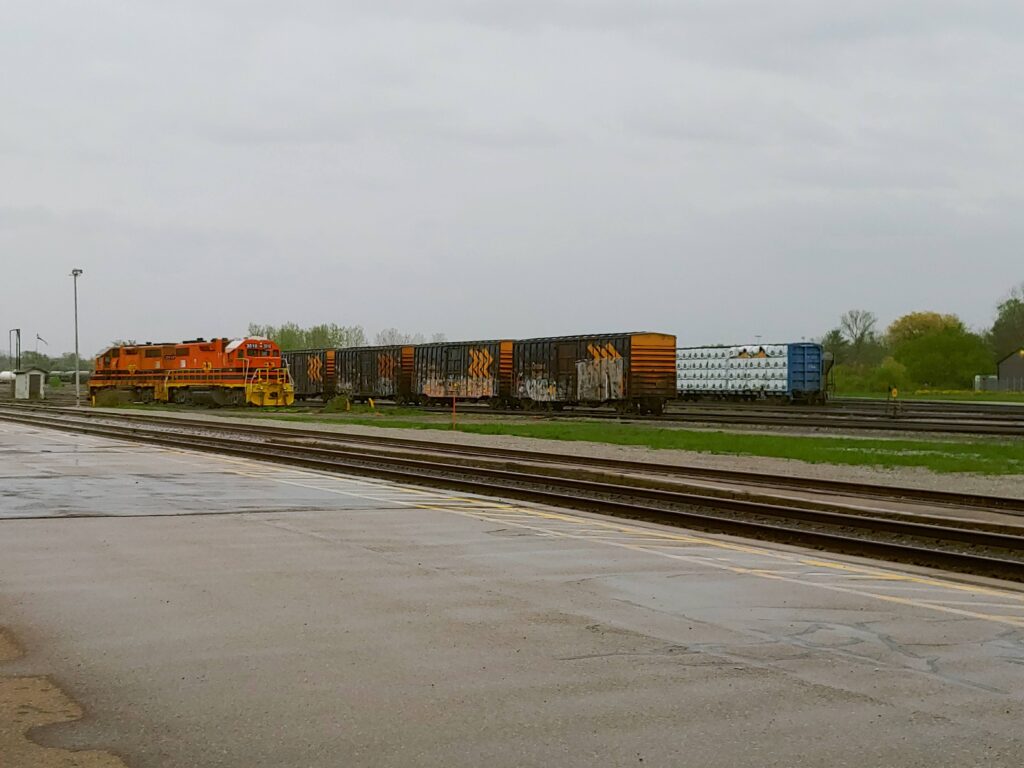
Arrival Of The Train
I made it to the platform just after 6:40am. While waiting for the train to arrive, fourteen other people showed up to wait alongside me. Some appeared dressed for work, while others like myself had on more casual attire. Some appeared to be making one leg of a longer journey, as indicated by the large bags they had on their person.
At 7:01am the first sign of the train could be heard by the faint sound of a distant horn. Two other horn sequences within the next two minutes suggested the train was crossing Packham Street, and Lorne Avenue respectively on the edge of town. At 7:15am, the train rounded the corner into view. Twin F59PH units #560 and #562 were on the head end pulling a short six car consist of bi-level coaches. It was exciting to see this pair as only eight of these older GO units were listed on the roster as of 2020. It was hard to tell from the outside, but there definitely appeared to be a handful of passengers seated within the six coaches. I boarded the rearmost coach and prepared to begin my journey.
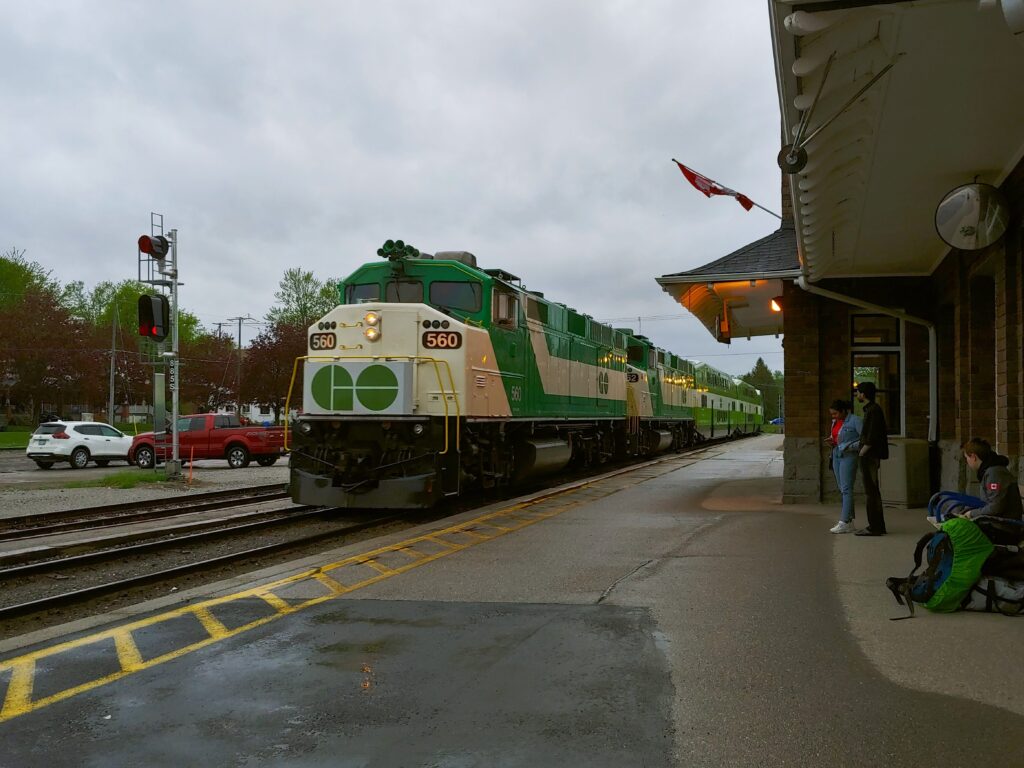
Stratford to Kitchener
At 7:17am my train departed Stratford. The six cars were no challenge for the twin units on the head end, and shortly we were up to a decent clip. Almost as soon as we got up to speed though, we began to slow down. The train continued at this slow pace across Perth Road 111 and both Forest Road crossings. Once past Forest Road, the train again returned to track speed.
Coming up the hill past Forest Road, some of the vast fertile farmlands that make up Perth County can be seen. Highway 7 / 8 is visible on the left and on this day we appeared to be outpacing the numerous cars and trucks heading in both directions. Shakespeare, the next community along the line, appears as a brief afterthought as the train passes through without stopping. The former station site is vacant today, however a large elevator continues to be serviced by CN local freights.
As we approached New Hamburg, we began to slow down again. The rails gently curve to the northeast as we cross the Highway 7 / 8 overpass. It is possible that the private driveways on either side of the overpass might be the reason for the slow down as we increased speed again once past them. We rolled through New Hamburg at a decent clip, passing the former station site off of Waterloo Street. Between New Hamburg and Baden, we hit the most significant slowdown of the trip. Upon reaching Nafziger Road, our speed decreased and we passed slowly through Baden. Our slow pace continued once past Baden. It is not known what the cause of this slow down was and no announcement was given. There are numerous private crossings between Baden and Kitchener, including one used by a gravel pit that was the site of a collision between VIA train 85 and a dump truck. It is wondered if perhaps a slow order was in place due to these crossings.
Once in the Kitchener city limits, our speed remained slow. By the time we reached the Fischer-Hallman Road bridge, we were down to a crawl. This continued until about Park Street where we sped up slightly as we pulled up to Kitchener VIA/GO Station, the next stop on this route. The time of our arrival was 8:06am.
As a former resident of Kitchener, it struck me how much the downtown area has changed since I moved away in 2018. One notable change is the King Street overpass, which replaced a former level crossing, and allowed for a grade separation for the ION LRT, which enters downtown Kitchener via King Street. The old level crossing can be seen in the second photo below.
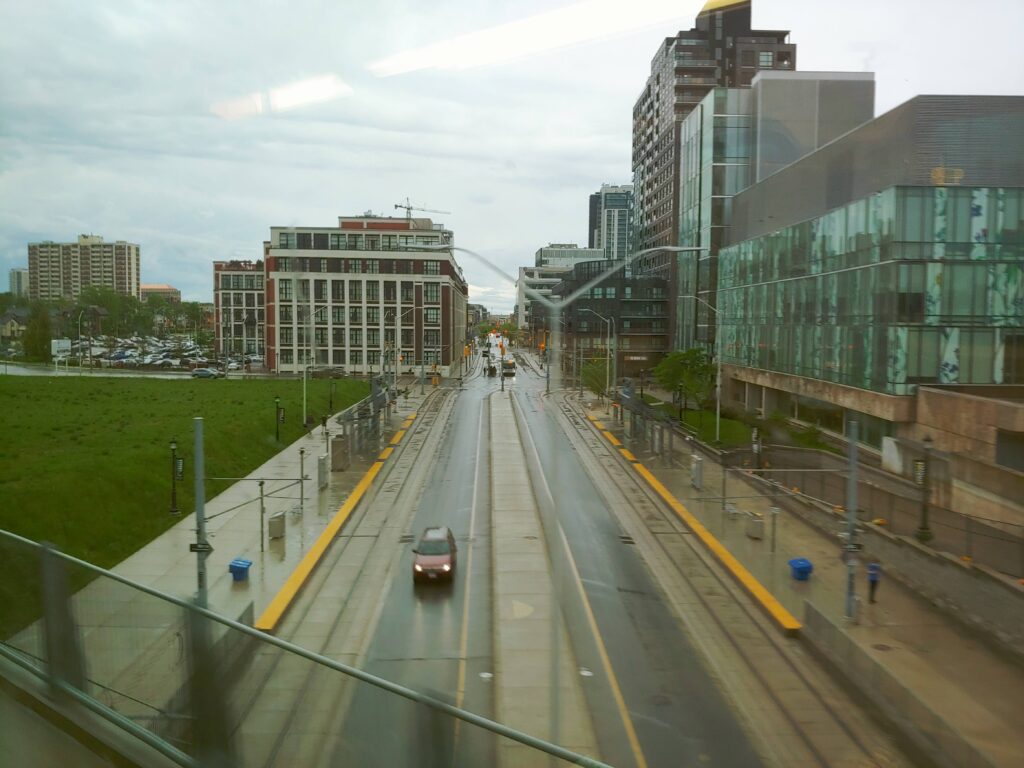
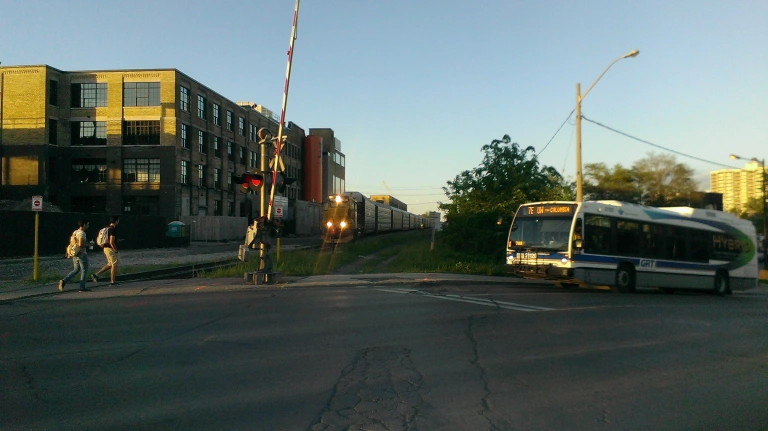
Kitchener to Georgetown
Our relatively quiet train began to fill up as numerous passengers boarded at Kitchener headed for Toronto and the GTA. My empty coach began to fill up and two fellow travelers joined me at my seating area. At 8:08am, our train departed Kitchener headed to our next station stop at Guelph. An eastbound CN freight was stopped on the passing siding just east of the station, and Kitchener’s ample yard appeared to be full of numerous freight cars
It is at this point that the pilot project portion of the trip ended and the regular service portion began. This was immediately noticeable in how the train operated. At this point, on board announcements by the train attendant started providing updates on next station stops, and what sides the doors would be opening on. These announcements had not occurred between Stratford and Kitchener. We continued at track speed all the way to Guelph. The tracks felt smooth with no significant bumps.
We made great time with no slowdowns between Kitchener and Guelph. The scenery along the way continued to be mostly farmland with some wooded areas sprinkled in. Highlights along the way included the large trestle over the Grand River at Breslau, and the large Shantz Station Terminal Grain Elevator. On approach to Guelph Central Station, a recent operations change became obvious. Trains operating between Guelph Junction and Guelph Central Station can now operate at a moderate track speed, as compared to the 10 mph crawl previously permitted. This is my first trip along this stretch since 2021 when this change was implemented, and it definitely saved us a lot of time. Check out this video showing a side by side comparison of the two speeds.
We arrived at Guelph Central Station at 8:24am. This GTR style building continues in active service today as a combined train station and bus terminal. CNR 4-8-4 6167 formerly stood across the tracks from the station, but was moved to nearby John Galt Park in 2020. We departed at 8:25am, crossing the Speed River and the former Canadian Pacific Goderich Subdivision (current Guelph Junction Railway operated by GEXR) via the large Allan’s Trestle. We got back up to track speed with little delay and passed under the “100 steps” pedestrian bridge, which was referenced in part five of the Railways and Craft Beer blog project I wrote for the TRHA.
The landscape at this point becomes more forested and hilly. We also begin to parallel Highway 7 just outside of Guelph, and we continue to outpace the vehicles traveling between 80-100 km/h on the highway. We lose sight of the highway as we curve through the town of Rockwood, crossing over the large Eramosa River trestle. The railway and highway rejoin each other east of Rockwood, and pass in close proximity until crossing each other beside the next station stop at Acton.
We arrived in Acton at 8:39am. Interestingly, it appeared that numerous passengers detrained at this stop. Seemingly many people had places to be in this small town of just under 10,000 people. At 8:40am we departed Acton heading for our next stop at Georgetown. Hills and trees begin to increasingly replace farms as we move into the Bruce Peninsula. The scenery became especially rugged as we passed through the cut at Limehouse. Shortly after then we began to slow down as we switched from the Guelph Subdivision to the double tracked Halton Subdivision, passing through the north end of town on a large embankment. We continued at a slow pace as we switch into the separated GO station tracks at Georgetown, coming to a stop at 8:51am. Across the tracks from us, the Georgetown GTR station still stands serving VIA Rail passengers. Furnace Room Brewery is also located across the tracks from GO station, another site featured in the Railways and Craft Beer blog series.
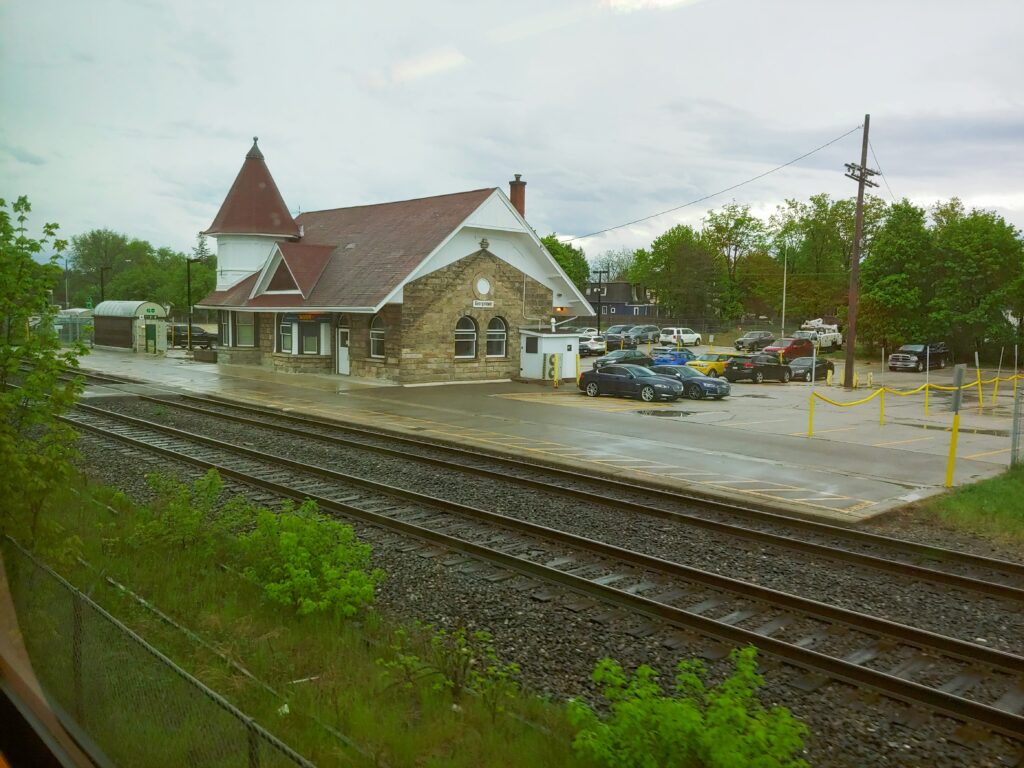
Georgetown to Brampton
At 8:52am we departed Georgetown GO station. We began to enter the fringes of the Greater Toronto Area. Fields and forests begin to be replaced by cleared land for subdivisions. One particular plot contained street lights for streets not quite fully developed. Nature still remains present, and a flock of wild turkeys was seen sitting in a still undeveloped field. Our train arrived at Mount Pleasant Station at 9:00am, one of three stops located within Brampton.

While I was unable to observe how many passengers arrived and departed at this stop, the massive parking lot at Mount Pleasant appeared to be relatively full of cars. It is clear that this stop is one of the more popular ones on the route. A stopped westbound CN freight could be seen idling at this station, and departed at the same time as our departure at 9:01am. The forests seen earlier were predominately replaced by industries and sound barriers by this point of the trip. The buildings also started to gradually become more industrial in nature. We pulled into Brampton station at 9:06am with no slowdowns. Shortly before this stop, we crossed the rails of the recently abandoned Orangeville and Brampton Railway, which saw its final train in December 2021. A section of this abandoned right of way was recently purchased by the City of Brampton for the purposes of future development.

Brampton to Toronto
While less busy than what I’ve observed in past trips, Brampton Station was still a busy hive of commuters. Any free seats available in my coach became occupied by commuters boarding at Brampton. The Grand Trunk station still stands in use here today on the north side of the tracks, which sadly was the opposite side of my window view. The likely only reason why the train wasn’t busier was the relatively late arrival and departure time of this train at this station from a commuter perspective. Despite the volume, we departed swiftly at 9:07am.
Commercial and residential properties composed the majority of buildings visible on my side of the train in downtown Brampton. Shortly after departing the station, we passed Tracks Brew Pub, featured in part five of my Railways and Craft Beer Blog. The Mississauga and Etobicoke skylines became visible through the clouds as we continued to pass through urban and commercial sprawl. Another stopped eastbound CN freight was seen tied down out front of our next station stop at Bramalea. Track crews were busy completing platform work around the station. One cool sight was the presence of a cement mixer sitting on the rails via a platform. Our train reached Bramela at 9:14am, departing at 9:16am. The neighbouring CN freight left at the same time as us, pulling ahead slowly towards the junction with the York Subdivision located just east of Bramalea.
The Brampton Intermodal Terminal became visible at this point as we passed under Highway 407. The fringes of Pearson International Airport also became visible on my side of the train as we approached our next station stop at Malton at 9:21am. This station allows passengers to access Pearson. From here, our train begins to parallel the rails of the Union Pearson Express. shuttle trains from Pearson to Union Station.
It struck me at this point just how much the GTA GO stations contrast with those further from the city. Most GTA GO stations on this line are small modern buildings (Brampton being the exception), and the parking lots sprawl out in all directions. It also appeared that the majority of these lots were either full or mostly full. In contrast, the Kitchener GO station is a large older building with a tiny parking lot that fills up quickly. We departed at 9:22am on our trip deeper into the heart of Toronto.
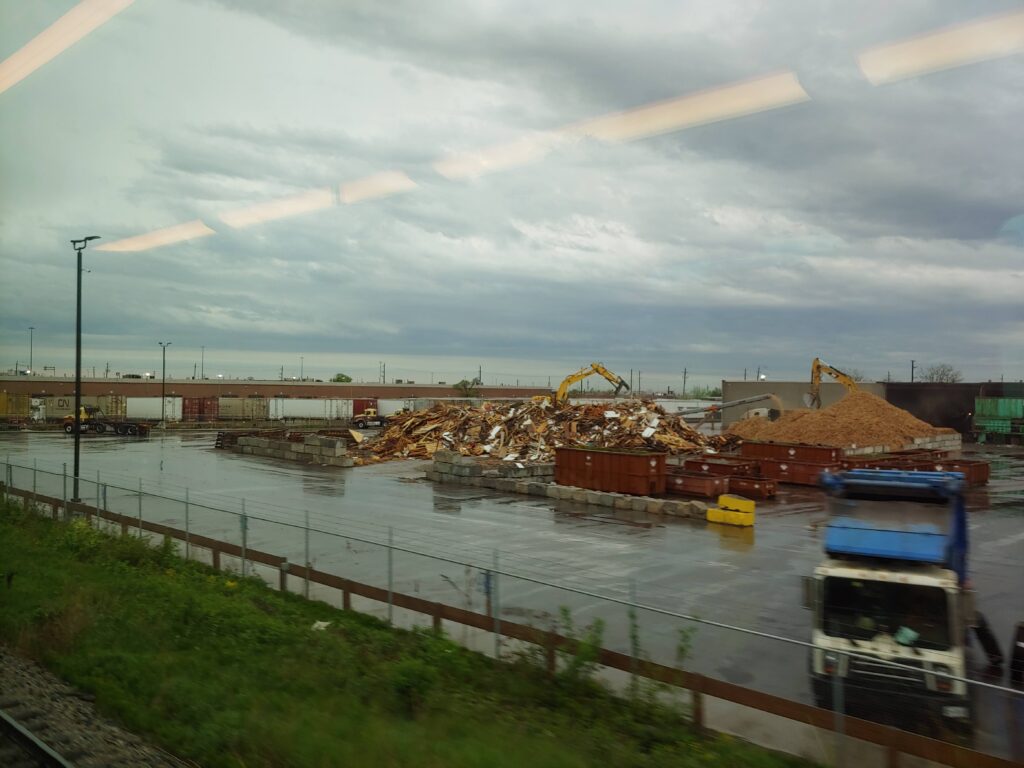
Many spurs branch off both sides of the Kitchener GO line into the various industries in northwestern GTA. Many have been seemingly abandoned since my last GO train trip in 2014. Some had rails partially removed, while others were buried in long grass. Some spurs were intact but the prescience of items parked on them suggested they were not in use.
Etobicoke North station was reached at 9:27am. It was also at this point that I noticed just how stiff my backside had become from hours on a GO train seat! Highway 401 passes just down the line from the station, and on this morning it is congested with numerous cars and trucks heading in both directions. We departed Etobicoke North at 9:28am, passing under Highway 401 via a long dark underpass resembling a tunnel. It sounded like another freight, possibly a local yard job, rumbled past on an adjacent track, but it was too dark to see it. Nature returned for a brief moment once past Highway 401 as we approached the Humber River. The Kitchener GO line crosses the river via a tall trestle, and the recognizable skyline of downtown Toronto sits visible above the trees. I was so impressed that I wasn’t able to get my camera up until it was too late.
The view at this point consists of numerous apartment buildings and parking garages. Weston GO station was reached at 9:33am, departing at 9:34am. Weston was one of many stations in the GTA where passengers boarded and unboarded on the opposite side of where I was seated, so I could not get an idea of the number of each. All the older train stations in the Weston area have long since been demolished. A transit hub, likely related to the Eglington Crosstown LRT became visible on my left with numerous new train sets stored there. Our speed was slower then in the country, but seemingly a decent clip for being within the city.
Bloor GO station was reached at 9:39am. Shortly before arriving at Bloor we passed through the extensive subway that carries the Kitchener GO line underneath the Canadian Pacific North Toronto Subdivision. This replaced the former West Toronto Diamond, and allows for passenger and freight trains to pass through the site uninterrupted and without significant slow downs. As a passenger who has ridden trains through this diamond, and had to wait for passing freights, I found the change efficient, however likely less desirable for railfans!
Our train departed Bloor GO station at 9:40am. Train traffic begin to increase once we departed the station, with a westbound UP Express slinking past heading to Pearson Airport, and a westbound GO train accelerating past on the Galt Subdivision. Our train took one last long sweeping curve through Liberty Village before joining the rails of the GO Lakeshore West line. Nothing but concrete and glass could be seen as we continued towards Union Station. As we slowed and navigated the labyrinth of tracks in the Union Station Rail Corridor, many familiar landmarks came into view. This included The CN Tower, Rogers Centre, and for a brief moment, the Toronto Railway Museum! I snapped a quick pic during the brief moment our museum was visible from the train.

Not long after our train slowly pulled into one of the many platforms at Toronto Union Station at 9:49am, twenty one minutes later than our 9:28am scheduled arrival time. The overall trip was two hours and thirty two minutes from the time we left Stratford until the time we came to a stop at Toronto Union Station. This is four minutes later then the two hour and twenty eight minutes this trip is scheduled
Toronto to Whitby
This was not the end of my journey though. I still had to get myself from Union Station to Whitby via a Lakeshore East GO train. I took the stairs down to the waiting room, and was fortunate to learn that the next Lakeshore East train was scheduled to arrive in just over ten minutes. After a short wait in the concourse, I went back up to the platform to catch my second GO train of the day. Coincidentally, my train was scheduled to arrive on the platform beside the train I took from Stratford. GO MP40 #650 slowly pulled into the station just as my earlier train departed west to be serviced. I snapped a quick photo of both trains side by side before preparing to board. Once again, I was able to get a window seat on the right side of a relatively empty coach.
My trip to Whitby was relatively straight forward, with my train departing at the scheduled departure time of 10:06am. We slowly clanked through the network of switches and cross overs east of Union Station while paralleling a busy Gardiner Expressway. We picked up speed as we crossed over the Don Valley Parkway, and powered up the steep grade between Union and our next station stop at Danforth. While stopped, I admired the development and parkland that stood on what was previously the Canadian National Danforth Yard.
Our train continued to wind along the Lakeshore East line, making scheduled stops at Scarborough, Eglington, and Guildwood GO stations. I had packed my notebook away at this point, meaning I did not capture the arrival and departure times of this train. As we approached Rouge Hill GO station, we crossed the only few level crossings along the Lakeshore East line, and streaked past the F.J. Horgan Water Treatment Plant. This point of the line is one of the most scenic sections on the GO network as the rails pass within close proximity to the shore of Lake Ontario. Our stop at Rouge Hill GO station allows for passengers such as myself to watch the waves crash on shore as well as joggers traversing the Waterfront Trail and Chesterton Shore Park.
After continuing to follow the Lake Ontario shore, and after a view of the Pickering Nuclear Generating Station, the Lakeshore East Rails swing north and then east again to parallel Highway 401 as well as circumvent Frenchmans Bay. After ducking under the unique curved trestle carrying the York Subdivision over Highway 401, our train makes its next stop at Pickering GO station. The rails at this point continue to follow the south side of Highway 401, and it’s always amusing to watch GO trains pacing the cars and trucks on the highway. The rails follow a relatively straight course with only two gentle curves between Pickering and Whitby. Our train made an uneventful stop at Ajax and then continued towards my final stop at Whitby. The rails felt smooth and the ride was comfortable as we traversed at a quick pace.
Our train arrived at Whitby GO station shortly after 11:00am, and only a few minutes later than the originally scheduled arrival time of 10:58am. This was the final stop on this journey. After departing, I walked through the pedestrian subway, tapped my Presto card, and passed through Whitby’s modest suburban station. My journey was now complete, just under four hours from when it started!

How Did This Trip Compare?
The overall time it took to travel from Stratford Station to Union Station was two hours and thirty two minutes, or four minutes later than the scheduled two hour and twenty eight minute trip, and the train made twelve station stops. The graph below displays a sample of past trains that have run scheduled trips on the Stratford-Toronto route over the past one hundred years. These train schedules were taken from timetables available in our database and from some provided by fellow TRHA History Team member Jeffrey Smith.
| Year | Railway Company | Train Number | Departure Time | Arrival Time | Scheduled Trip Duration | Number of Stops |
| April 30th, 1922 | Grand Trunk Railway | 26 | 5:30am | 8:30am | 3 Hours | 19 |
| April 30th, 1922 | Grand Trunk Railway | 28 | 7:40am | 10:10am | 2 Hours 30 Minutes | 18 |
| June 26th, 1927 | Canadian National Railway | 26 | 5:25am | 8:27am | 3 Hours 2 Minutes | 19 |
| June 26th, 1927 | Canadian National Railway | 28 | 7:40am | 10:10am | 2 Hours 30 Minutes | 18 |
| June 22nd,1947 | Canadian National Railway | 10 | 4:34am | 7:10am | 2 Hours 36 Minutes | 17 |
| June 22nd, 1947 | Canadian National Railway | 28 | 7:20am | 10:00am | 2 Hours 40 Minutes | 19 |
| October 27th, 1957 | Canadian National Railway | 10 | 4:55am | 8:00am | 3 Hours 5 Minutes | 20 |
| October 27th,1957 | Canadian National Railway | 28 | 7:17am | 9:50am | 2 Hours 33 Minutes | 20 |
| April 30th, 1978 | VIA Rail | 660 | 6:45am | 8:55am | 2 Hours 10 Minutes | 7 |
| October 25th, 1992 | VIA Rail | 80 | 8:39am | 10:35am | 1 Hour 56 Minutes | 5 |
| June 1st, 2010 | VIA Rail | 86 | 6:10am | 8:20am | 2 Hours 10 Minutes | 5 |
| July 7th, 2014 | VIA Rail | 84 | 8:34am | 10:50am | 2 Hours 16 Minutes | 6 |
| May 16th, 2022 | GO Transit | 3710 | 7:17am | 9:49am | 2 Hours 32 Minutes (scheduled duration 2 Hours 28 Minutes) | 12 |
The 2 hour 28 minute scheduled trip of the GO train I rode is similar to that of train 28 operated by the Grand Trunk and Canadian National Railways. It is also similar to the duration of CNR Train 10 in 1947, however that train’s trip increased by three stops and nearly a half hour of travel time by 1957. The VIA Rail trips in the second half of the 20th century were much shorter then my GO train trip in 2022, with significantly fewer stops to make. Travelers in 1992 could seemingly make the trip in under two hours. My GO train trip seems to fall about in the middle of these earlier trains in terms of overall duration and number of stops.
It should be noted that VIA train 84 is a slightly faster option in the present day, scheduled to take two hours and twenty two minutes, which is six minutes faster then GO Train 3710. However, VIA 84’s arrival time of 11:16am to Stratford means it cannot be used to arrive in Toronto during the morning hours.
Summary
Overall my trip was an enjoyable experience! Ultimately I was able to achieve my goal of getting from Stratford to Whitby without using a car. It was very apparent to me which part of the route was part of the pilot project, and which part was a regular GO line. I was very surprised that it took fifty-one minutes to travel from Stratford to Kitchener. To compare, it takes me about forty minutes to drive from my home to my office in Kitchener, and that trip requires a backtrack off the Expressway involving multiple four way stops. I’m very curious what the reason for the numerous slowdowns were between Stratford and Kitchener. Was it track conditions? Slow order requirements due to the private crossings? Or something else?
While a two hour and thirty two minute trip does seem long, it is reasonable given the use of conventional equipment, the distance between Stratford and Toronto, and the many stops along the way. GO trains seats are designed for shorter commutes, and even the refurbished seat in the newer coach I was seated in started to get uncomfortable once the two hour mark was passed. GO train sets are also not designed to hold large items of luggage, and don’t contain a baggage car. The suitcase I had with me took up most of the leg space at my seat, as well as the seat across from me. If this service is to continue and increase in frequency, additional space should be made for baggage. While many travelers are commuters into the city for work, many others, including myself, will also want to use this train for travel purposes.
Improvements to the Kitchener GO line have been discussed for years with some being implemented in the past few years. When I first began photographing GO trains in 2016 while living in Kitchener, all GO trains were directional based on the morning and evening commute. All morning trains were eastbound to Toronto, and all evening trains were westbout out of the city. As of 2022, there has been an increase in two way service between Kitchener and Toronto. This two way service has not been extended to Stratford as part of the pilot project. If this project were to continue as regular service, then two way service would open up accessibility of these trains.
One final thought I have about this service is its use for shorter trips. A lot of focus has been made on how long this trip takes along its entire duration from London to Toronto. I see this service as being effective for shorter trips along the line. I could see myself taking this train one or two stops from Stratford to Kitchener, London, or St Marys in order to travel for work or to see friends and family. The schedule of this train currently would make this a challenge though. While I could make it to Kitchener in time for work or for stores to open, I would have to wait around for a long while until the return train arrives at 6:22pm. Also with one train eastbound in the morning, and the other westbound in the evening, I would only be able travel west of Stratford late in the day.
Conclusion
It’s not perfect, however it is a pilot project so there are still things to figure out. Overall I enjoyed my trip and the overall experience. I hope that this train goes past the pilot project stage and can expand into a two way all day service allowing for increased rail travel across Southwestern Ontario. The area is growing each year, especially with more and more people moving away from the city to more rural communities that are more affordable to live in.
This service is great but not sustainable. Overtime if improvements are not made to this pilot project, the public will lose interest, and choose to either drive to their destinations, or to more established stations outside of Perth County. This goes directly against the rationale of commuter rail transit, which is to take more cars off of the road. I am looking to seeing how this service grows, and looking forward to the next time I “Go” on a train ride into the city.

References
Allen, D. (2022). From Train Service to Bar Service: Links to Ontario Railway History in Craft Beer (Part Five). Toronto Railway Historical Association. Retrieved on July 15th, 2022 from https://www.trha.ca/trha/from-train-service-to-bar-service-links-to-ontario-railway-history-in-craft-beer-part-five/
Allen , D. (2021). From Train Service to Bar Service: Links to Ontario Railway History in Craft Beer (Part Four). Toronto Railway Historical Association. Retrieved on July 15th, 2022 from https://www.trha.ca/trha/from-train-service-to-bar-service-links-to-ontario-railway-history-in-craft-beer-part-four/
Buy GO Transit E-Tickets and Passes Online. (2022). GO Transit. https://tickets.gotransit.com/en-us/
Bytown Railway Society. (2020). Canadian Trackside Guide 2020 (E. Roberts & D. Stremes, Ed.). Gilmore Printing Services Inc.
Canadian National Railway 6167. (2021) Guelph Historical Railway Association. https://www.ghra.ca/railway-history/canadian-national-railway-6167/
GO Transit Expansion Pilot To London Brings New Connections To Southwestern Ontario. (2021), Metrolinx. https://blog.metrolinx.com/2021/09/15/go-transit-expansion-pilot-to-london-brings-new-connections-to-southwestern-ontario/
Kitchener Man Airlifted To Hospital After His Dump Truck Collides with Train. June 17th, 2020. The Record. https://www.therecord.com/entertainment/2010/06/17/kitchener-man-airlifted-to-hospital-after-his-dump-truck-collides-with-train.html (Updated April 8th, 2020)
KryptoTransit. (2021, December 9). GO Transit: Guelph Speed Restriction Before and After Comparison. [Video]. YouTube. https://www.youtube.com/watch?v=PZdU4FHZp8E&ab_channel=KryptoTransit
Robinson, D. (2012). Railway Stratford Revisited. Stratford Printing and Graphics.
Rumbolt, R. (2022, January 11) Brampton Pays More Than $24M For Downtown Orangeville Railway Land. Insauga. https://www.insauga.com/brampton-pays-more-than-24m-for-downtown-railway-land/
Vivian, R. (2021, October 15) GO Train Speeds To More Than Quadruple Through Guelph. Guelph Today. https://www.guelphtoday.com/local-news/go-train-speeds-to-more-than-quadruple-through-guelph-4515823#:~:text=With%20a%20number%20of%20upgrades,72%20km%2Fh%20on%20Dec
Wilson, I. (2000). To Stratford Under Steam. Canadian Branchline Miniatures.

